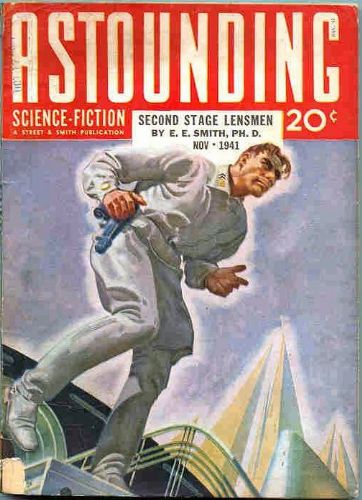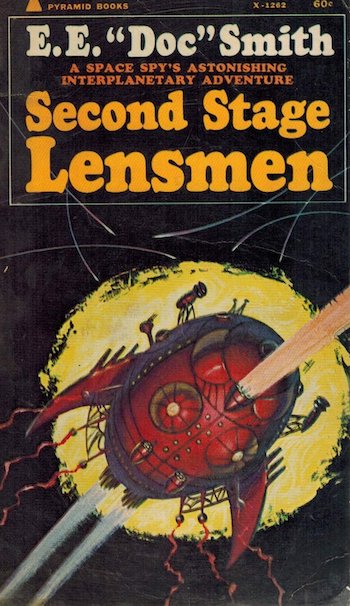In this bi-weekly series reviewing classic science fiction and fantasy books, Alan Brown looks at the front lines and frontiers of the field; books about soldiers and spacers, scientists and engineers, explorers and adventurers. Stories full of what Shakespeare used to refer to as “alarums and excursions”: battles, chases, clashes, and the stuff of excitement.
Second Stage Lensman is the third book of Smith’s original trilogy chronicling the story of Lensman extraordinaire Kimball Kinnison, the star-traveling lawman. The first book, Galactic Patrol, followed his meteoric rise through the ranks. The second book, Gray Lensman, followed the efforts of the Lensmen as they tracked the evil forces of Boskone to a planet in the Second Galaxy, obliterating it between two mobile planets. At the end of that novel, Kim was ready to take a well-earned rest and marry his sweetheart, Clarissa MacDougall. But this book starts with a telepathic call from Arisia, warning that his job is far from done. Once again, Doc Smith cranks up the stakes for our favorite adventurer. You can tell the pressure is rising because Kim, who swears by the spacer god Klono when surprised or under stress, drops the “K” word left and right in this book!
The cover painting for the copy I reviewed (as seen above) is by Jack Gaughan—a vivid action shot of a spaceship in combat. Unlike typical science fiction book covers from the mid-1960s, it has a nice steampunkish look to it, but I don’t feel the composition lives up to some of his other work for the series. I very much liked the cover used by Astounding for the serialized novel, shown below. Artist Hubert Rogers really captures the feel of Kimball Kinnison at the height of his powers, poised and ready for action.
While, as mentioned above, Second Stage Lensmen is the third book of the Lensman series in the order they were written, it is the fifth book of the Lensman series by internal chronological order. I’ve already reviewed prequel books Triplanetary and First Lensman, which covered the founding of the Lensmen and Galactic Patrol, along with the two previous adventures of Kimball Kinnison, Galactic Patrol and Gray Lensman. And in the coming months, I will be reviewing the last two books in the series: Children of the Lens and The Vortex Blaster. I’d missed reading these books in my youth, so this is my first visit to the world of the Lensmen. Once more, I thank Julie at Fantasy Zone Comics and Used Books for finding copies of the Lensman books and making this review series possible.
About the Author
Edward Elmer Smith (1890-1965), often referred to as the “Father of Space Opera,” wrote under the pen name E. E. “Doc” Smith. I included a complete biography in my review of Triplanetary.
As with many authors who were writing in the early 20th century, a number of works by Smith can be found on Project Gutenberg, though unfortunately this does not currently include a version of Second Stage Lensmen.
“Girls” in Space
The Lensman series was written during a time of rigid segregation between the gender roles. American society in the mid-20th century viewed gender as a strict binary. Men were seen as breadwinners and warriors, and women were seen as nurturers and homemakers. Variations from these norms were frowned upon by conventional society. And since most science fiction was marketed as literature for men, it is no surprise that women generally played a limited role in many of these tales. The pulp literature of the time was full of stories where there were no women at all, or perhaps an occasional waitress, nurse, mother, or maiden made an appearance. Women were almost never protagonists in these stories, but generally appeared to support the hero, feature as a love interest, or to be in need of rescue. In some cases, a woman played the role of femme fatale or villain, where the hero might find his attraction battling with the need to foil her evil plans.
Doc Smith’s stories are no exception to these old tropes. But while he portrays women in limited roles, I see no evidence of any malice or prejudice in his attitudes; instead, while Smith largely seems to be a product of his time, he does stretch the old limits a bit by sometimes giving women roles with more agency. In Triplanetary, while Clio Marsden mostly existed to be a love interest for Conway Costigan, she was a plucky character who performed ably in a pinch. And in First Lensman, the character Virgilia Samms was a capable intelligence agent. However, when Virgilia was initially selected to travel to Arisia with an early group of Lensman candidates, she was ultimately refused, and recounted her meeting with Mentor as follows:
…Women’s minds and Lenses don’t fit. There’s a sex-based incompatibility. Lenses are as masculine as whiskers—and at that, only a very few men can ever wear them, either… Men with tremendous force, drive, and scope. Pure killers, all of you; each in his own way, of course. No more to be stopped than a glacier, and twice as hard and ten times as cold. A woman simply can’t have that kind of a mind! There is going to be a woman Lensman some day—just one—but not for years and years; and I wouldn’t be in her shoes for anything…
This exemplifies those rigid 1950s attitudes toward gender roles at their most pervasive. Smith envisioned Lensmen of all races, sizes, shapes, metabolisms and species—but he also imagined that each of those races operated along the same gender binary he ascribed to humans, and the power of the Lens was restricted to the males.
In Second Stage Lensmen, there is a plotline that also runs headlong into gender issues, where Kim Kinnison follows a zwilnik, or drug dealer, to the planet Lyrane. This planet is unique in being inhabited by a species whose females resemble humans, while their males are tiny, unintelligent brutes that the females only come in contact with for reproduction. Kim wonders why the zwilnik would choose to travel to Lyrane, since he will not be able to hide among the women. Until he finally sees the zwilnik, it never occurs to Kim that he might be a she (for a hero with superpowers, he can sometimes be a bit dense).
The women of this matriarchy, since they have no men they need to please, pay little or no attention to their appearance, do not appreciate the arts, and eat in communal dining halls. This sounds more than a little dubious to me, and I wonder if Doc Smith ran that scenario past his wife or daughters or women colleagues before submitting his manuscript. Kim is dismissive, and even abusive, when he talks to the women, bragging that his race is notable because of the equality of the sexes. Later in the book, Smith again makes the point that, “Indeed, it has been argued that sexual equality is the most important criterion of that which we know as Civilization.” Considering the fact that the book portrays Kinnison as a member of a legion of Lensmen, and a Galactic Patrol for that matter, made up entirely of men, traveling and fighting on ships crewed entirely by men, protecting a civilization led by men, the statement is laughable. From today’s perspective, the society of the mid-20th century, and the universe in the Lensmen that reflected that society, offered anything but gender equality…
Interestingly, the interaction with Lyrane’s Matriarchy, in addition to offering Doc Smith the opportunity to present some Gulliver’s Travels-esque satire, does end up producing the slightest of cracks in these rigid gender roles… And by the end of this book, we are introduced to the one and only female Lensman.
Second Stage Lensmen

The book opens with the postponement of Kim and Clarissa’s wedding plans, when Mentor of Arisia makes rare contact to remind Kim that the destruction of the enemy’s headquarters on the planet Jarnevon (in fact, the destruction of the entire planet) did not mark the end their conflict. The evil forces of Boskone were not all destroyed, and now that the enemy has observed the ability to move planets with massive Bergenholm drives, and the Patrol creating negaspheres of a kind of anti-matter, they will likely be developing similar weapons. In keeping with this constant escalation of weapons, Lensman Worsel develops a concealable weapon for Kinnison which is far more powerful than his beloved DeLameter blasters.
Civilization drops everything to prepare for an attack on its capitol planet of Tellus. The Galactic Patrol replaces their massive “mauler” battleships with even more powerful “super-maulers.” Small, uninhabited planets are relocated for possible use as massive projectiles. They upgrade their flagship Directrix so it can coordinate even larger fleets, and develop a weapon called the “sunbeam,” which sounds rather innocuous, but harnesses the power of the sun itself, channeling it into a beam of incredible magnitude. And indeed, a colossal battle opens the book, in which the enemy uses whole planets as gun platforms, and attacks via hyperspatial tubes that allow surprise assaults. These battles always give Doc Smith a chance to employ the most lurid prose, such as, “Bolt after bolt of quasi-solid lightning struck and struck and struck again. Q-type helices bored, gouged, and seeringly bit. Rods and cones, planes and shears of incredibly condensed pure force clawed, tore and ground in mad abandon.” But the Lensmen and the Patrol are victorious, and Kinnison heads out again on his warship, Dauntless, to gather intelligence and track their forces.
This brings him, as mentioned above, to the Matriarchy of Lyrane. The zwilnik he follows, Illona, surprisingly turns out to be a nice person, from a planet so deep into Boskonian territory that its inhabitants know no other culture. But as they are heading home, another call comes from Lyrane, where they are under attack from pirates. Kinnison and the Dauntless turn around and save the day in a ferocious land battle, and he is left with a mystery to solve: Where did the pirates come from, and why do they want to capture Lyrane? A Lensman must be stationed on Lyrane, in order to get to the bottom of the problem, but any man they picked would obviously stand out like a sore thumb. There are, after all, no female Lensmen. To his horror, Kim realizes that his beloved Clarissa is the perfect candidate to become a female Lensman, and when Mentor and Clarissa both agree, she is given a Lens and inducted into their ranks. Back in those days, women in pulp adventures were often referred to by their hair color (blonde, brunette, or redhead), and in keeping with that, rather than using terms of rank adopted by the other Lensmen, Clarissa becomes known as the Red Lensman.
Illona is not skilled in navigation and has no idea where her home planet is located, but the unique gems in her jewelry offers clues, so while Clarissa goes undercover on Lyrane, Kinnison goes undercover as a jewel dealer to find Illona’s planet of origin. He ends up on the planet Lonabar, taking on Bleeko, the head crime lord. While I enjoy the spaceship and battle parts of the Lensman books, I must admit these secret agent interludes and cover identities are my least favorite parts of the stories. Suffice it to say that Kim finds what he wants, which takes him back to the Lyrane system. There is a secret base belonging to the evil Overlords, who Kim has battled in the past. And Clarissa has discovered that women are disappearing, victims of this nest of villainous aliens. This operation will require the full powers of the Second Stage Lensmen—including a new one that has been helping Kinnison. Nedrick is an intriguing character, an ultra-cautious being from an ultra-cold planet, whose different perspective becomes invaluable as the narrative unfolds.
To avoid spoiling too much, I’ll leave the rest of the details unstated. Suffice it to say, that nest of villains leads to clues of yet another enemy headquarters, more undercover work and aliases for Kinnison, more space battles, and more mind-blasting encounters with evil aliens. There is a happy ending, with room for more adventures in the future, as the larger battle of the evil Eddorians versus noble Arisians remains unresolved.
Final Thoughts
Second Stage Lensmen is another rollicking adventure, perfect for reading in the backyard on a summer day. If you are in the mood for pulp, it is a great read, full of lurid, pulpy goodness. You will roll your eyes at the dated gender roles, and smile at the often purple prose, but it is a fun read. There are only two more books for me to read in the Lensman series, and to be honest, I’m going to be sad when I’ve reached the end.
And now, it’s time for you to chime in: What do you think of Second Stage Lensmen and the series as a whole? I always look forward to everyone’s comments and recollections of reading the books.
Alan Brown has been a science fiction fan for over five decades, especially fiction that deals with science, military matters, exploration and adventure.










